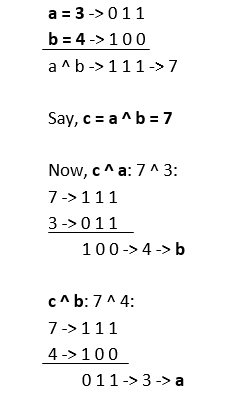Python Tutorial
Python OOPs
Python MySQL
Python MongoDB
Python SQLite
Python Questions
Plotly
Python Tkinter (GUI)
Python Web Blocker
Python MCQ
Related Tutorials
Python Programs
Python Bitwise XOR OperatorBinary language is the language of a computer. All the inner mechanisms of a computer happen concerning bits. Bitwise operators are the set of operators that allow the programmer to perform bitwise operations on integers. These operators allow the programmer to manipulate the lower-level data in a computer. There are a total of six bitwise operators in Python:
This article discusses the Bitwise XOR operator with examples.
Now, let us understand the operation of Bitwise XOR:
Operation:
The truth table of XOR:
Let us understand the concept using an example: If we want to perform: 3 ^ 4: 1. Both the integers are converted into binary forms: 3 -> 0 1 1 4 -> 1 0 0 2. Now, xor is applied bitwise: 
3. Finally, the resultant binary number is converted back to its decimal form. 1 1 1 represents 7 4. Output -> 7 3 ^ 4 -> 7 Now, for the same operands, let us write a code for xor: Output: 
On Boolean values:We can perform xor on Boolean values. When we operate on two integers, 1 is equivalent to Boolean True, and 0 is equivalent to Boolean False. Truth table:
Output: 
Structure of outputs:
Let us take the above example: 
Code: Output: 
Understanding: If a ^ b -> c Then, c ^ a -> b c ^ b -> a
Role of xor in cryptography:The above relation got xor a small role in cryptography models.
Example: If A wants to send the message 3 to B and their secret key is 4 3 ^ 4 -> 5. A will send 5 to B. B already knows the secret key is 4. He will decrypt the message using xor again: 5 ^ 4 -> 3 Message successfully received.
Next TopicPython New Line
|
 For Videos Join Our Youtube Channel: Join Now
For Videos Join Our Youtube Channel: Join Now
Feedback
- Send your Feedback to [email protected]
Help Others, Please Share










